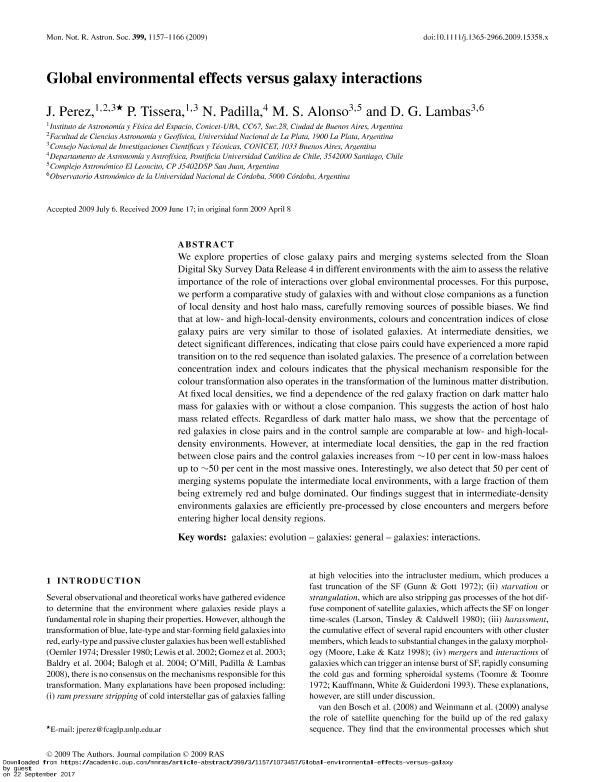Mostrar el registro sencillo del ítem
dc.contributor.author
Perez, Maria Josefa

dc.contributor.author
Tissera, Patricia Beatriz

dc.contributor.author
Padilla, Nelson David

dc.contributor.author
Alonso Giraldes, Maria Sol

dc.contributor.author
Garcia Lambas, Diego Rodolfo

dc.date.available
2017-09-22T17:47:01Z
dc.date.issued
2009-10
dc.identifier.citation
Perez, Maria Josefa; Tissera, Patricia Beatriz; Padilla, Nelson David; Alonso Giraldes, Maria Sol; Garcia Lambas, Diego Rodolfo; Global environmental effects versus galaxy interactions; Oxford University Press; Monthly Notices of the Royal Astronomical Society; 399; 3; 10-2009; 1157-1166
dc.identifier.issn
0035-8711
dc.identifier.uri
http://hdl.handle.net/11336/24944
dc.description.abstract
We explore properties of close galaxy pairs and merging systems selected from the Sloan Digital Sky Survey Data Release 4 in different environments with the aim to assess the relative importance of the role of interactions over global environmental processes. For this purpose, we perform a comparative study of galaxies with and without close companions as a function of local density and host halo mass, carefully removing sources of possible biases. We find that at low- and high-local-density environments, colours and concentration indices of close galaxy pairs are very similar to those of isolated galaxies. At intermediate densities, we detect significant differences, indicating that close pairs could have experienced a more rapid transition on to the red sequence than isolated galaxies. The presence of a correlation between concentration index and colours indicates that the physical mechanism responsible for the colour transformation also operates in the transformation of the luminous matter distribution. At fixed local densities, we find a dependence of the red galaxy fraction on dark matter halo mass for galaxies with or without a close companion. This suggests the action of host halo mass related effects. Regardless of dark matter halo mass, we show that the percentage of red galaxies in close pairs and in the control sample are comparable at low- and high-local-density environments. However, at intermediate local densities, the gap in the red fraction between close pairs and the control galaxies increases from ∼10 per cent in low-mass haloes up to ∼50 per cent in the most massive ones. Interestingly, we also detect that 50 per cent of merging systems populate the intermediate local environments, with a large fraction of them being extremely red and bulge dominated. Our findings suggest that in intermediate-density environments galaxies are efficiently pre-processed by close encounters and mergers before entering higher local density regions.
dc.format
application/pdf
dc.language.iso
eng
dc.publisher
Oxford University Press

dc.rights
info:eu-repo/semantics/openAccess
dc.rights.uri
https://creativecommons.org/licenses/by-nc-sa/2.5/ar/
dc.subject
Galaxies
dc.subject
Evolution
dc.subject
Interactions
dc.subject
Environments
dc.subject.classification
Otras Ciencias Físicas

dc.subject.classification
Ciencias Físicas

dc.subject.classification
CIENCIAS NATURALES Y EXACTAS

dc.title
Global environmental effects versus galaxy interactions
dc.type
info:eu-repo/semantics/article
dc.type
info:ar-repo/semantics/artículo
dc.type
info:eu-repo/semantics/publishedVersion
dc.date.updated
2017-09-21T18:02:20Z
dc.journal.volume
399
dc.journal.number
3
dc.journal.pagination
1157-1166
dc.journal.pais
Reino Unido

dc.journal.ciudad
Oxford
dc.description.fil
Fil: Perez, Maria Josefa. Consejo Nacional de Investigaciónes Científicas y Técnicas. Oficina de Coordinación Administrativa Ciudad Universitaria. Instituto de Astronomía y Física del Espacio. - Universidad de Buenos Aires. Facultad de Ciencias Exactas y Naturales. Instituto de Astronomía y Física del Espacio; Argentina
dc.description.fil
Fil: Tissera, Patricia Beatriz. Consejo Nacional de Investigaciónes Científicas y Técnicas. Oficina de Coordinación Administrativa Ciudad Universitaria. Instituto de Astronomía y Física del Espacio. - Universidad de Buenos Aires. Facultad de Ciencias Exactas y Naturales. Instituto de Astronomía y Física del Espacio; Argentina
dc.description.fil
Fil: Padilla, Nelson David. Pontificia Universidad Católica de Chile; Chile. Consejo Nacional de Investigaciones Científicas y Técnicas; Argentina
dc.description.fil
Fil: Alonso Giraldes, Maria Sol. Consejo Nacional de Investigaciones Científicas y Técnicas. Centro Científico Tecnológico Conicet - San Juan. Complejo Astronómico "El Leoncito". Universidad Nacional de Córdoba. Complejo Astronómico "El Leoncito". Universidad Nacional de la Plata. Complejo Astronómico "El Leoncito". Universidad Nacional de San Juan. Complejo Astronómico "El Leoncito"; Argentina
dc.description.fil
Fil: Garcia Lambas, Diego Rodolfo. Universidad Nacional de Cordoba. Observatorio Astronomico de Cordoba; Argentina. Consejo Nacional de Investigaciones Científicas y Técnicas; Argentina
dc.journal.title
Monthly Notices of the Royal Astronomical Society

dc.relation.alternativeid
info:eu-repo/semantics/altIdentifier/doi/http://dx.doi.org/10.1111/j.1365-2966.2009.15358.x
dc.relation.alternativeid
info:eu-repo/semantics/altIdentifier/url/https://academic.oup.com/mnras/article/399/3/1157/1073457
dc.relation.alternativeid
info:eu-repo/semantics/altIdentifier/url/https://arxiv.org/abs/0904.2851
Archivos asociados
